
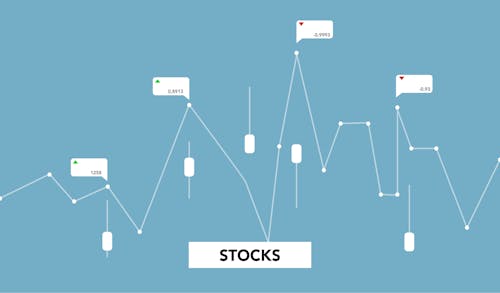 Image Source: PexelsFinancially speaking, the markets have been all over the map in the past four years since the onset of Covid and the self-inflicted wounds from the forced economic shutdown. I went back to August 2020, five months after the festivities began, and pulled up some charts that show the price action since then for gold (money), wheat (food), crude oil (energy), and stocks (S&P 500). I will make some comments after each chart and provide observations at the end of the article. We’ll start with gold…
Image Source: PexelsFinancially speaking, the markets have been all over the map in the past four years since the onset of Covid and the self-inflicted wounds from the forced economic shutdown. I went back to August 2020, five months after the festivities began, and pulled up some charts that show the price action since then for gold (money), wheat (food), crude oil (energy), and stocks (S&P 500). I will make some comments after each chart and provide observations at the end of the article. We’ll start with gold…
Gold Prices (August 2020-April 2024)
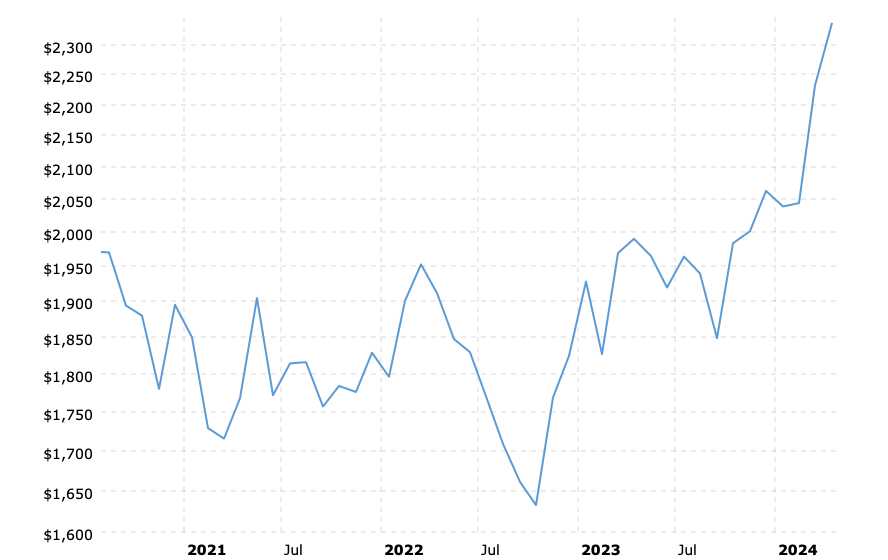 Peak prices for gold reached in August 2020 at or near $2000 oz. were not exceeded until late last year, more than three years later. Currently, gold is up about eighteen percent from its average closing price ($1971) in August 2020. At one point, in October 2022, the gold price was down by a similar amount and percentage.
Peak prices for gold reached in August 2020 at or near $2000 oz. were not exceeded until late last year, more than three years later. Currently, gold is up about eighteen percent from its average closing price ($1971) in August 2020. At one point, in October 2022, the gold price was down by a similar amount and percentage.
Oil Prices (August 2020-April 2024)
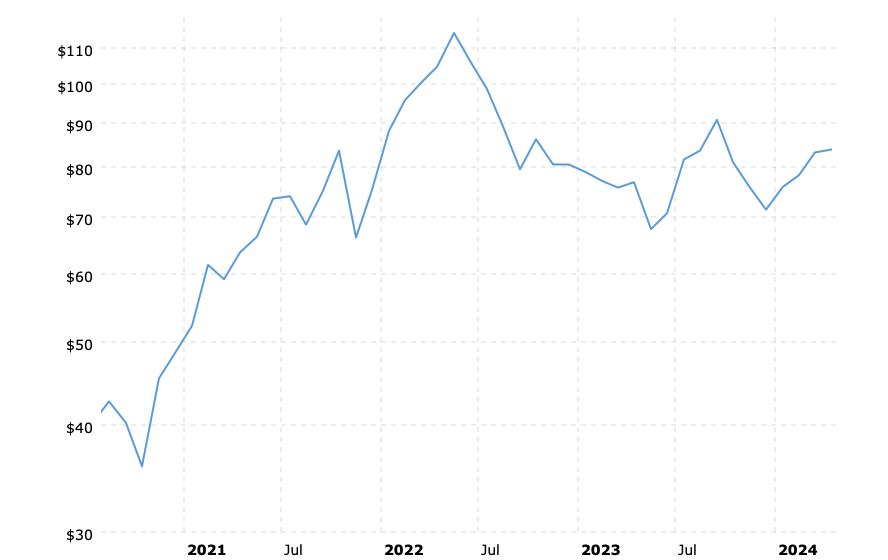 Since August 2020, the price for a barrel of crude oil has risen sharply from $51 to a current price of $83; an increase of sixty-two percent. Almost two years ago, though, the price was at $114. There has been a decline of twenty-seven percent since then.
Since August 2020, the price for a barrel of crude oil has risen sharply from $51 to a current price of $83; an increase of sixty-two percent. Almost two years ago, though, the price was at $114. There has been a decline of twenty-seven percent since then.
Wheat Prices (August 2020-April 2024)
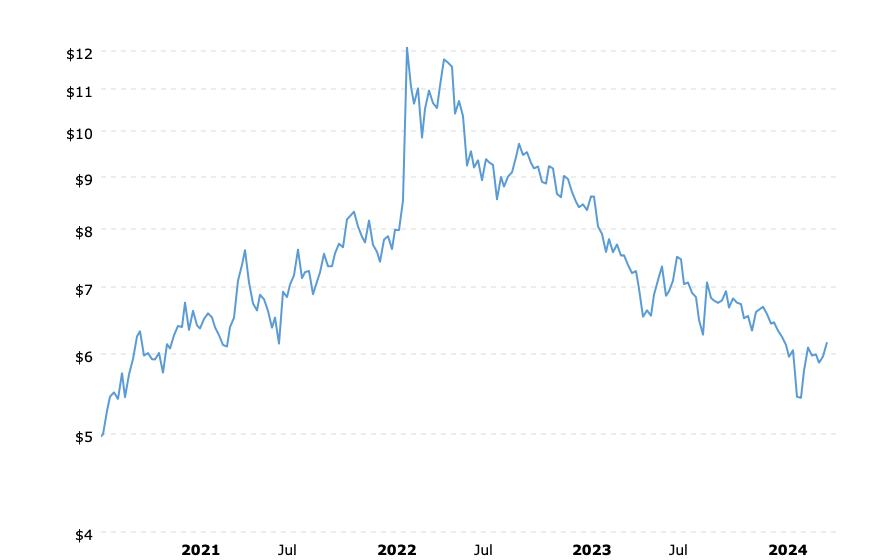 The price of wheat soared from $5 per bushel to $12 (up 140%) in barely a year and one-half; then collapsed by almost sixty percent. Currently, at about $6 per bushel, wheat is up twenty percent since August 2020.
The price of wheat soared from $5 per bushel to $12 (up 140%) in barely a year and one-half; then collapsed by almost sixty percent. Currently, at about $6 per bushel, wheat is up twenty percent since August 2020.
S&P 500 Index (August 2020-April 2024)
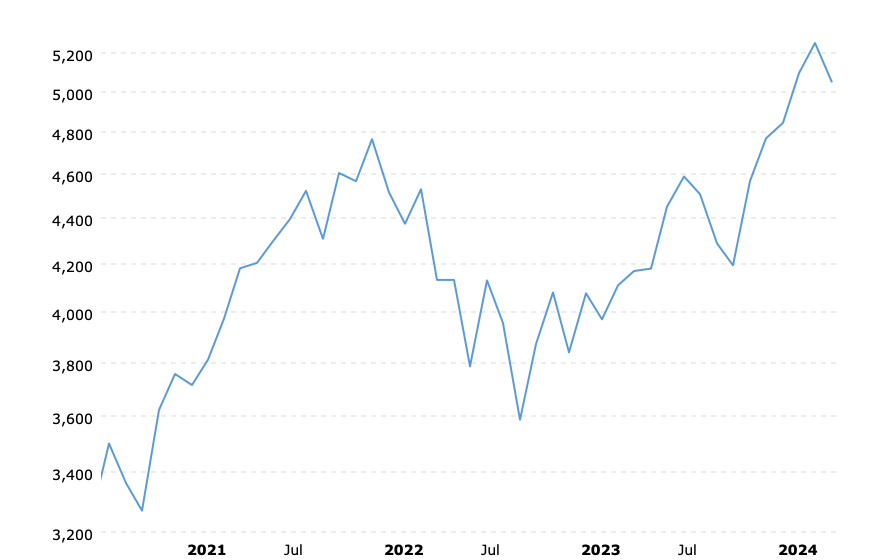 Since August 2020, the S&P 500 stock index has risen by forty-four percent, increasing from 3500 to 5048. At one point in 2022, stocks had dropped one-third in price almost wiping out previous gains after August 2020. The relentless move higher afterward is quite impressive, regardless of fundamentals or logic to the contrary.THOUGHTS AND OBSERVATIONSBy late 2020, most markets had risen quite assertively from their Covid-induced lows. There was no let-up in sight, though. Oil, wheat, and stocks continued their runs upward without hesitation. Gold refused to join the party and the others soon topped out and followed suit with all of them dropping for most of 2022 as lower interest rates took their toll on the markets.Beginning in late 2022, rumors, hints, and speculation about the possibility of a Fed pivot sent stocks and gold higher. Wheat and oil prices continued lower for the time being.At this point, wheat is the biggest loser, down fifty percent from its peak in February 2022, net of its recent rebound from the $5 level. That seems somewhat surprising. The effects of inflation have shown up in higher prices for goods and services, especially food and groceries. It seems reasonable that a healthy portion of the earlier wheat price increase was attributable to the effects of inflation. Supply chain disruptions likely accounted for the balance. So, why the sharp reversal and decline in the wheat price afterward? I don’t see evidence that food prices are coming down. Are wheat speculators deflationists?The descent in oil prices was arrested last October when Palestinian militants attacked southern Israel from the Gaza Strip. Iran has shown its cards, too. As long as tensions remain high in the Middle East, oil prices will be more vulnerable to upside shocks. But the downside could be just as shocking, depending on the circumstances. We saw an example of that with the economic shutdown during Covid. Without further escalation of fighting which could disrupt oil supplies and deliveries, might oil prices be much lower right now, along with wheat prices?The rising cost of money (higher interest rates) has had observably negative effects on the financial markets. Higher prices for the stocks seem more anticipatory of the beneficial effects of lower interest rates if/when they happen. It doesn’t seem reasonable that stock prices could keep making all-time highs while bond prices flirt with twenty-year lows and have been decimated by higher interest rates. The booze isn’t as cheap as before, but it is still available for now, apparently. That could change quickly. If it does, stock prices could drop faster and farther than bonds, or, anything else. Putting it in perspective, the increase in the gold price of eighteen percent doesn’t seem to warrant the enthusiasm that it is being accorded. Rather than a cause for celebration, it is merely a reflection of the most recent effects of inflation – the loss of purchasing power in the U.S. dollar that has occurred over the past four years. At $2338 oz. today, gold is still cheaper than its August 2020 inflation-adjusted price of $2375 ($1971). Gold’s price action is evidence of its role as a long-term store of value. More By This Author:Gold Stocks Vs Gold – Choose Gold
Since August 2020, the S&P 500 stock index has risen by forty-four percent, increasing from 3500 to 5048. At one point in 2022, stocks had dropped one-third in price almost wiping out previous gains after August 2020. The relentless move higher afterward is quite impressive, regardless of fundamentals or logic to the contrary.THOUGHTS AND OBSERVATIONSBy late 2020, most markets had risen quite assertively from their Covid-induced lows. There was no let-up in sight, though. Oil, wheat, and stocks continued their runs upward without hesitation. Gold refused to join the party and the others soon topped out and followed suit with all of them dropping for most of 2022 as lower interest rates took their toll on the markets.Beginning in late 2022, rumors, hints, and speculation about the possibility of a Fed pivot sent stocks and gold higher. Wheat and oil prices continued lower for the time being.At this point, wheat is the biggest loser, down fifty percent from its peak in February 2022, net of its recent rebound from the $5 level. That seems somewhat surprising. The effects of inflation have shown up in higher prices for goods and services, especially food and groceries. It seems reasonable that a healthy portion of the earlier wheat price increase was attributable to the effects of inflation. Supply chain disruptions likely accounted for the balance. So, why the sharp reversal and decline in the wheat price afterward? I don’t see evidence that food prices are coming down. Are wheat speculators deflationists?The descent in oil prices was arrested last October when Palestinian militants attacked southern Israel from the Gaza Strip. Iran has shown its cards, too. As long as tensions remain high in the Middle East, oil prices will be more vulnerable to upside shocks. But the downside could be just as shocking, depending on the circumstances. We saw an example of that with the economic shutdown during Covid. Without further escalation of fighting which could disrupt oil supplies and deliveries, might oil prices be much lower right now, along with wheat prices?The rising cost of money (higher interest rates) has had observably negative effects on the financial markets. Higher prices for the stocks seem more anticipatory of the beneficial effects of lower interest rates if/when they happen. It doesn’t seem reasonable that stock prices could keep making all-time highs while bond prices flirt with twenty-year lows and have been decimated by higher interest rates. The booze isn’t as cheap as before, but it is still available for now, apparently. That could change quickly. If it does, stock prices could drop faster and farther than bonds, or, anything else. Putting it in perspective, the increase in the gold price of eighteen percent doesn’t seem to warrant the enthusiasm that it is being accorded. Rather than a cause for celebration, it is merely a reflection of the most recent effects of inflation – the loss of purchasing power in the U.S. dollar that has occurred over the past four years. At $2338 oz. today, gold is still cheaper than its August 2020 inflation-adjusted price of $2375 ($1971). Gold’s price action is evidence of its role as a long-term store of value. More By This Author:Gold Stocks Vs Gold – Choose Gold
I Bought A Stock (AU) At 20; Now It’s 23 – Am I Rich?
Chair Powell’s Speech & Fed Independence















